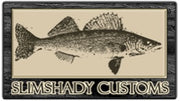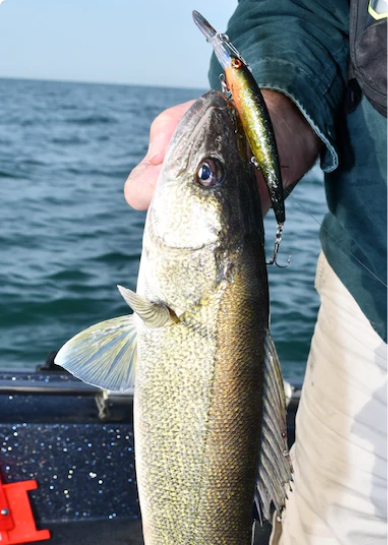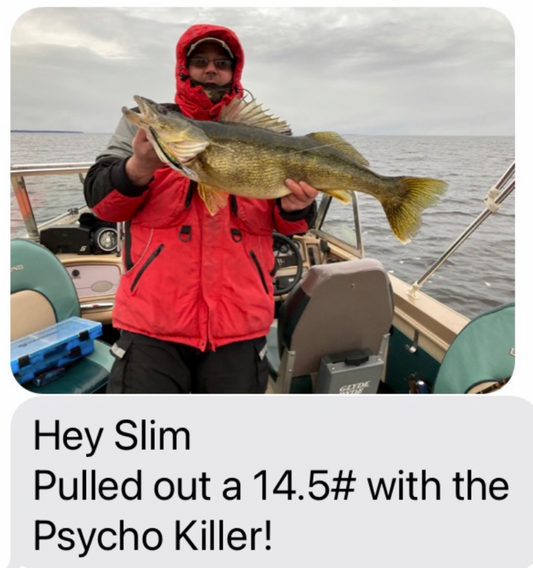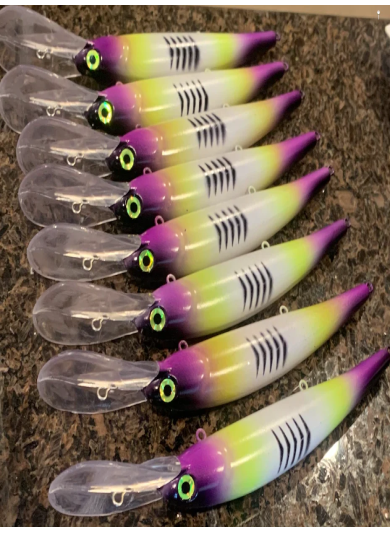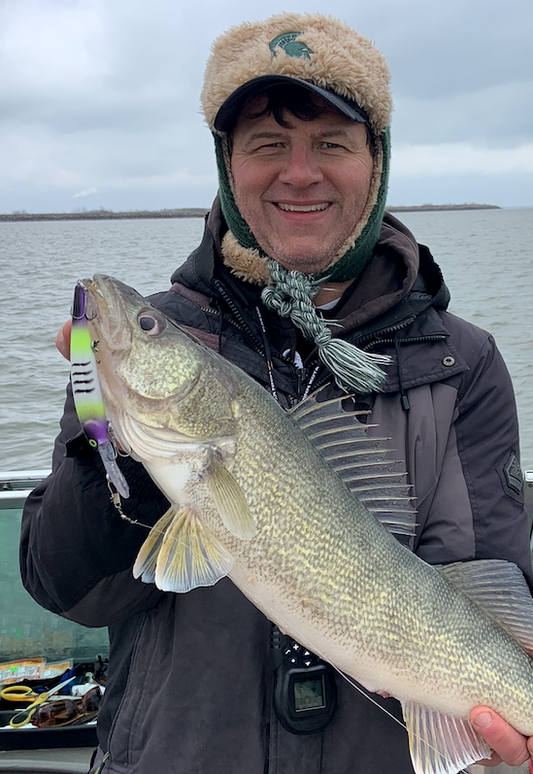Article: Tips for painting your own custom baits, Part 1: Finding blanks
Have you thought about making some of your own lure designs just for the fun of it, but didn’t know where to begin? Are you concerned about the up-front investment in air-brushes, compressors, paint, etc? Are you worried that you would waste time and effort painting lures that won’t actually work after you are done?
I thought I would share some of the things that I have learned through this journey and help those of you who might be interested in making a few lures to use for themselves, or even to sell. This article is Part 1 of a series of articles that I have written about the lure making process. Part 1 will focus on lure blanks. As I was about to write this, I debated whether I should dedicate an entire article to blanks. I ultimately decided that I should, because putting effort into painting a lousy blank is like putting a $5,000 paint-job on a car that won’t run. I learned the hard way on that one. Details to follow.
Before I dive into those details about blanks, I wanted to start with some background on how I got to this point. I have been a fisherman virtually my whole life. I am 54 now and I started fishing when I was 3 with my dad and grandpa on the Missouri River impoundments in South Dakota (Oahe & Francis-Case). We started fishing the Erie/St. Clair system back in the early 80s shortly after moving to this area. Back then we caught tons of walleyes trolling Wiggle-warts and Hot-N-Tots straight behind the boat, even though we had no clue what we were doing back then. We had the benefit of fishing during one of the “hey-day” eras for the Western Basin. The good news is that we are now experiencing another one of those eras.
I have been a lure maker for 20+ years, however, I never intended to get into the lure making business. Over the years I have made thousands of harnesses, jigs, stinger hooks, blade-baits, spoons, etc., for my own use. I have also made my own planer boards, planer board masts, tattle-flag kits for my in-line boards, casting deck for my boat, etc. I am always tinkering with new projects and ideas. Some of my ideas turned out great, others not so much.
Like the time (many years ago) I was trying to train my dog to “come” and not run-away when we let him outside. Whenever he got loose it was a nightmare getting him back in the house, as he thought it was fun having us chase him all over the neighborhood. I decided that I needed a longer “leash” so that I could give him more freedom, yet still be able to keep him from running if he didn’t obey my commands. I went into the garage and found the heaviest rod and reel combo that I had and tied on a heavy-duty snap-swivel that I attached to his collar. I found out very quickly that my equipment was woefully outmatched! I thought a King Salmon pulled hard until I tried turning a 40 lb dog running in the opposite direction! It was like trying to land a marlin on a “Hello Kitty” combo from Walmart. Here I was running down the street trying to gain line on him before he ”spooled me”, while my wife was watching out the kitchen window. I wasn’t sure if she was laughing her a** off or calling a divorce attorney. We are still married, so I am glad she got a good laugh out of it. More than one, as she still brings it up from time to time. Put that one in the “L” column, for sure.
When it comes to making fishing gear, it’s not that I don’t like what is already on the market, it’s just that I enjoy tinkering and the challenge of seeing if I can make something on my own. In my opinion, there’s nothing more satisfying in the sport of fishing than catching fish on lures that I designed and created. As I mentioned earlier, I never intended to turn this hobby into a business. Initially, I bought a few blanks and decided to paint them up for my own use. I tried them on Lake St. Clair and caught fish on all of them the very first trip, which was awesome. I shared the pictures on the MI Sportsman’s Forums, and people started asking me if I could make them some. The next thing I knew, I had 15-20 patterns and had sold a few hundred of them. That’s when I decided to build a webstore and take it up a few notches. Who knows where it will go from here, but I still enjoy making them and helping others who are just getting started.
Here's a picture of the “original 6” baits that I painted for myself. Most of them have evolved into patterns that I still make today.

In the photo above, the top pattern evolved into "New Bleeding Shad", the second one down evolved into "Nuclear Perch", the 3rd one down became "Sunrise Shad", the 4th one down became "Smokeshow Shad", and the bottom one evolved into "Pimp Daddy Perch".
Not all blanks are created equal
Out of the gate, there are really three top-level choices that any lure-maker has when selecting lure blanks. We can purchase clear versions of the lure from the manufacturer, take them apart and paint them; we can try to find “knock-off” blanks from another supplier online; or we can use balsa and carve something of our own. There are pros and cons to each option, however, that is a debate for another time. For this article, I am going to focus on the “knock-off” option.
I bought the “original 6” blanks from Backwater Outfitters (https://backwateroutfitting.com). They have a few different “Bandit style” blanks to offer. I bought 6 of their “Ultra Clear Banditos”. I was very impressed with the quality of those blanks, as they are almost a perfect match with the real ones. However, the downside with those is that they are relatively expensive @ $3.50+ per-blank. By the time I added 3 decent treble hooks & split-rings, my cost basis was over $5 each, and that was before paint, eyes, clear-coat, etc. At that rate, I would probably just buy actual Bandits. I wanted to buy more of them at bulk-rate pricing, but they wouldn’t budge, so I kept searching.
I guess size and shape really does matter....of the bill that is..
I had a few buddies that were making them as well, so I asked them where they were getting their blanks. Most of them were buying them on E–Bay from a variety of sources. The cost per-blank ranged from $1.50 on the low end, up to $3 or so on the higher-end, depending on the supplier and the quantity. I ordered a batch of them and decided to give them a shot. At first glance, they seemed ok. The body looked very similar to the ones I had before, however, the bill was quite different. It was a bit wider, more squared-off and much thicker than the “Ultra-Clear Banditos”. They were also much “cloudier” than the “Ultra-Clear Banditos”, so I guess those are appropriately named.
I made a bunch of lures for myself and sold a bunch of them using these blanks as well. I tested them on Lake Erie in April and noticed right away that many of them needed significant tuning or they would come to the surface. When tuned properly, they ran ok at the speeds we were running at that time (1.4 – 1.6 mph), yet it was clear that they also pulled much harder than real Bandits (or the Ultra-Clear Banditos). They did catch fish, so that was a positive thing.
As spring rolled into summer, we started pulling our crankbaits much faster and that was when I realized that there was a significant problem with the “cheaper” blanks. No matter how much I tried tuning them, they tended to “spin-out” and come to the surface. They also pulled so hard that they would either pop the front release on the boards, or we would think there was a fish on, yet when we brought them in there was nothing but the lure. By then I had already switched suppliers and was using much better blanks. However, I knew that I also had a bunch of customers out there that had purchased lures from me using these blanks, so I needed to do something to rectify that situation. I went back and checked my order records to see when I made the “cut-over” to the new blanks and which customers ordered prior to that time and started to figure out a plan to “make it right”. I ended up either repairing the old ones or making it easy for those clients to replace them with newer lures. If there’s anyone out there reading this article that purchased baits from me prior to mid-April of 2021 and is not happy with how they run, please reach out to me so we can work something out. I will go into more details about how I repaired the old blanks at the end of this article, for anyone that is interested in reading about that.

The photo above shows the difference between the "cheapo" blanks from Ebay that didn't run well (left) and my current blanks (right). You can see the difference in shape and clarity.

In this photo (above), you can easily see the difference in thickness between the old blanks (top) and my current blanks (bottom).
Consistent Quality is also important
After a few more “swings and misses” with other suppliers online, I finally found one that had decent looking blanks at a fair price. However, with blanks, it is nearly impossible to know for sure how good they are until you paint some of them up and actually test them to see how they run. When I received the first batch of blanks from this supplier, I looked them over very thoroughly and compared them to the various ones that I had used before (and to actual Bandits). The good news was that their shape (both the body and the bills) were nearly identical to the real ones (and to the Ultra-Clear Banditos). They were also not as “cloudy” as the ”cheapos” that I had been getting through EBay. I painted some up and they ran great! Most of them needed zero tuning from the get-go, and they were easy to tune when there was an issue. As far as I could tell, they ran just like the real ones.
However, the bad news was that their quality was inconsistent. About 70% of the blanks in that initial batch had significant manufacturing defects, most where the two sides are joined together. I had to super-glue each one along the seam before I could begin painting them. Here’s an example of the defects that I am referring to:

I took random samples of 100 blanks and collected stats on how many were “good” and how many had issues. I sent them pictures of the defects and “threatened” to switch suppliers if they couldn’t find a way to improve the quality. The next shipment was significantly better, and it has continued to improve with each shipment since. My latest shipment of 1000 blanks has been the best quality that I have seen so far and they keep getting better each time. After more than a year of searching, sampling and repairing, I finally have a reliable source for decent blanks at a very reasonable price. They are the same blanks that I offer via my webstore, for those who are interested in purchasing some (https://slimshadycustoms.com/collections/unpainted-blanks).
I also have an order of 2000 chrome plated blanks from the same supplier that I expect to receive sometime in March. I have also started dabbling with other types of blanks. B-Shad style, shallow divers, bass cranks, etc. As I learn more about those, I may do a follow-up article.

The photo above shows an actual Bandit on the left and one of my current blanks on the right. Note: Mine has epoxy on the bill, which is why there is more light refraction, otherwise they have similar clarity.
Repairing the “bad” blanks:
I had made a good portion of my own baits from the “bad” blanks, and had exchanged some others for my clients. Therefore, I had a bunch of them that I wasn’t sure what to do with. I didn't want to sell them, because that would only create more of the same problem that I was already dealing with. I decided to see if I could repair the old blanks and make them run better. I decided to use a real Bandit as the template and traced a line around the bills of the “cheapo” blanks, and then used my grinder to reshape them to match. I also changed their thickness so that they were similar to the newer ones. Here’s an example of what that looks like:

I was able to test them immediately in my backyard pool to see how the modifications affected their action. The modified lures ran SO much better! It was night and day.
Just for kicks, I decided to make two more templates for the bills that were narrower than actual Bandits. The narrowest one was similar in width to a DDHJ. The last one was just “in-between” the other two and was not based on anything in the market.
Here's a picture of the 3 versions:

After testing all 3 versions in my pool, I decided that there wasn’t much difference between the “narrow” and the “medium”. However, there was a significant difference between the “standard” and the “narrow” in terms of the action on the bait. The standard bills create a wide, aggressive wobble. The narrow bills create a much tighter, more subtle wobble, which is similar to the DDHJ. I ditched the middle one and just stuck with the “standard” and the “narrow”. Since I had plenty of standard ones with my new blanks, I modified all of my lures that were made from the “cheapo” blanks into the “narrow” version. I put them in separate boxes and labeled them so I could keep things organized when we were fishing.
The next time out, I used the narrow baits on one side and the standard baits on the other. The fishing was so good that it was impossible to keep track through the chaos. However, everything we put out there caught fish. As the water temps dropped in the late fall, it was clear that the narrower baits did very well. In fact, some days they were the hottest baits we had out. I would love to be able to purchase blanks in both a “standard” or “narrow” versions, however, at this point that is not an option. Therefore, if I want a narrow version, I need to modify a standard bill using my grinder.
It takes time and effort to make the modifications, however, if anyone wanted to buy some of the narrow ones, please send me an email and we can work something out.
